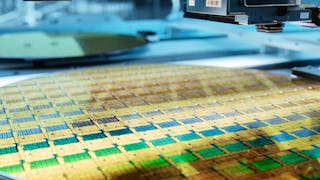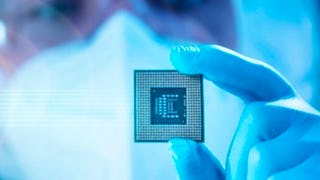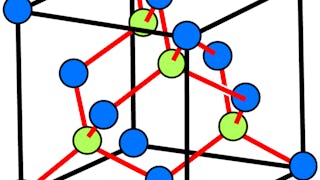In this course, we will explore the electrical properties of materials and classify different materials as conductors, semiconductors or insulators. We will look at some examples of conductors, semiconductors and insulators, and note the key factors that cause the differences in their electrical properties. We will use rudimentary band theory to show how temperature impacts the conductivity of the three classifications of materials. We will learn what causes the differences in electrical behavior of a p-type versus an n-type semiconductor in a p-n diode.


Electrical Properties and Semiconductors
This course is part of Materials Science for Advanced Technological Applications Specialization

Instructor: Terry Alford
3,376 already enrolled
Included with
(43 reviews)
Recommended experience
What you'll learn
Electrical properties of materials and, how/why semiconductors, insulators, and conductors are classified.
Skills you'll gain
Details to know

Add to your LinkedIn profile
2 assignments
See how employees at top companies are mastering in-demand skills

Build your subject-matter expertise
- Learn new concepts from industry experts
- Gain a foundational understanding of a subject or tool
- Develop job-relevant skills with hands-on projects
- Earn a shareable career certificate

There are 5 modules in this course
In this course, we will explore the electrical properties of materials and classify different materials as conductors, semiconductors or insulators. We will look at some examples of conductors, semiconductors and insulators, and note the key factors that cause the differences in their electrical properties. We will use rudimentary band theory to show how temperature impacts the conductivity of the three classifications of materials. We will learn what causes the differences in electrical behavior of a p-type versus an n-type semiconductor in a p-n diode.
What's included
1 video1 reading
Semiconductor devices require precise control of electrical properties. In this module, we learn about the electrical properties of various materials including conductors, semiconductors and insulators.
What's included
4 videos8 readings1 assignment2 discussion prompts
Semiconductor devices use both extrinsic and intrinsic semiconductor materials. In this module, we learn about extrinsic semiconductors and about different kinds of semiconductor devices.
What's included
3 videos8 readings1 discussion prompt
In this module we learn about different kinds of semiconductor devices and how they are used for different applications.
What's included
4 videos8 readings
In this Module, we will identify and explain the use of carrier concentration in semiconductors.
What's included
5 videos8 readings1 assignment1 peer review1 discussion prompt
Earn a career certificate
Add this credential to your LinkedIn profile, resume, or CV. Share it on social media and in your performance review.
Instructor

Offered by
Explore more from Mechanical Engineering
 Status: Free Trial
Status: Free TrialArizona State University
 Status: Free Trial
Status: Free TrialArizona State University
 Status: Free Trial
Status: Free TrialArizona State University
 Status: Free Trial
Status: Free TrialUniversity of Colorado Boulder
Why people choose Coursera for their career




Learner reviews
43 reviews
- 5 stars
79.06%
- 4 stars
11.62%
- 3 stars
4.65%
- 2 stars
2.32%
- 1 star
2.32%
Showing 3 of 43
Reviewed on Jun 24, 2024
got semiconductor properties cleared on conceptual level
Reviewed on Feb 26, 2023
My experience of learning was amazing and i learn a lot that will definitely helful to add the value in my career in futureThank you.

Open new doors with Coursera Plus
Unlimited access to 10,000+ world-class courses, hands-on projects, and job-ready certificate programs - all included in your subscription
Advance your career with an online degree
Earn a degree from world-class universities - 100% online
Join over 3,400 global companies that choose Coursera for Business
Upskill your employees to excel in the digital economy
Frequently asked questions
To access the course materials, assignments and to earn a Certificate, you will need to purchase the Certificate experience when you enroll in a course. You can try a Free Trial instead, or apply for Financial Aid. The course may offer 'Full Course, No Certificate' instead. This option lets you see all course materials, submit required assessments, and get a final grade. This also means that you will not be able to purchase a Certificate experience.
When you enroll in the course, you get access to all of the courses in the Specialization, and you earn a certificate when you complete the work. Your electronic Certificate will be added to your Accomplishments page - from there, you can print your Certificate or add it to your LinkedIn profile.
Yes. In select learning programs, you can apply for financial aid or a scholarship if you can’t afford the enrollment fee. If fin aid or scholarship is available for your learning program selection, you’ll find a link to apply on the description page.
More questions
Financial aid available,

